Easy Guitar Tips
Yes, there IS an easier way!
Maybe "Easy Guitar" is misleading. Maybe I should call this "Insider Tips," or better still "Stuff I wish I'd known when I started playing guitar."
First, a quick story to illustrate how important knowledge is...
One day the heater went out in Bob's home. He did what most people do: He called a plumber. The plumber comes out and looks at the heater for a minute, then reaches into his toolbox and pulls out a hammer. He brings his arm up and slams the hammer down on the corner of the heater, which immediately starts working. The plumber looks at Bob and says, "That'll be $120." Bob is astounded. "What!?! $120? For what?!" The plumber looks at him and explains, "It's $20 for hitting the heater with my hammer, and $100 for knowing where to hit it."
Knowledge is power.
These easy guitar tips give you additional knowledge. Use them and you should be able to play songs that are otherwise above your abilities.
Some of these easy guitar tips are shortcuts (for example, Tip #1). Others are useful for simplifying chords, but are also great for adding texture when playing with others (such as Tip #2). It's OK to use any of these when you need them, or when they add to the music. Please, don't use them to avoid practice or improving your skills.
What Are YOUR Best Tips? I hope this article helps you to develop as a player, but I also encourage you to share your hard-earned tips with others. Please take a moment to Share Your Best Tips. What lessons have you learned that make you a better player? What one tip or trick can you pass along? What do you wish you had known when you started that might help others?
Enjoy These Tips, then take a few minutes to share Your Best Tips.
Tip 1: Play Fewer Chords
Quite often chords are listed that add flavor to the song. If you're singing... if you're playing with others... or if you just want to keep it simple, use the first easy guitar tip and don't play every chord listed.
For example: Our church band played "Hark! The Herald Angels Sing" one Christmas. The first verse was written:
F C F C F/A Bb F C F
Hark the herald angels sing, "Glory to the newborn King";
Frankly, I couldn't keep up. So, I started dropping chords.
How do you know which chords to drop?
Begin by playing a passage using only the main chord (in this case, F, which happens to also be the key of the song). If a section sounds bad, or dull, it's time to try adding the listed chord back in.... or to try one of the other easy guitar tips.
You may find, as I did for this song, that simply repeating one chord where several were listed, sounds fine.
As your skills improve, start adding chords back in.
Tip 2: Play Only Part Of The Chord
Who says you have to strum the chord exactly the way the chord charts lay it out?
When you're starting out, you'll have more fun playing easy guitar rather than fully accurate chords!
So... if you're struggling to get from one chord to another, drop part of the chord form.
I recommend dropping the lower pitched strings. Why? Because chances are you're working on open chords. Some open chords require you to not play the lower-E string, and sometimes the A string. So, simplify a difficult chord form by playing only the high-e, B, and G strings.
For example, it is not uncommon to struggle with the switch from G-major to C-major. Here's how the chords are normally played:
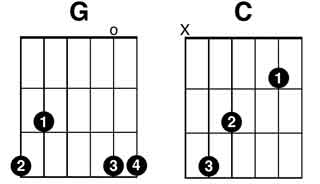
Most people make the switch from G to C by moving the 1-finger first, then moving the 2 & 3. This takes time and lots of practice. Until you can make the switch smoothly, try the easy guitar way... play only the first three strings, as shown below:
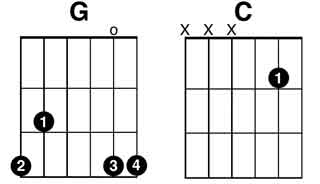
How do you avoid playing the top three strings? Either use the palm of your strumming hand to mute the strings (place the edge of your strumming hand immediately above the bridge), or don't strum them at all... whichever is easier for you.
I've shown you the simplified transition from a G to a C chord, but this technique works for any open chord. If you struggle changing from C to G, for example, play the C normally, place the 3 & 4 fingers for the G chord and play only the first three strings.
Tip 3: Find Another Chord Form
It's easy to forget that chords are made up of notes, not forms.
Many beginners don't even realize there are many ways to play every chord. Don't assume that there's only one form just because that's all you've learned so far. This easy guitar tip will show you how to discover alternate forms that are easier to play.
For example, the F-major open chord is difficult for many beginners.
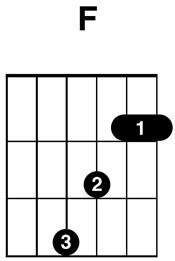
The D-chord, on the other hand, is typically one that most beginners master quickly.
Wouldn't it be nice if we could use the D-chord form to play an F chord?
Well, you can... if you slide the D-form up the fretboard three frets and play only the strings that are part of the D-chord form. The new F chord looks like this:
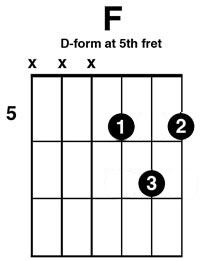
Easy form... Easy guitar!
Tip 4: Change the Key (or use a Capo)
Some songs are made for easy guitar playing, because they use chord forms you find easy to play.
If Silent Night is played in D, the chords are: D, G, and A. These chords are relatively straight forward for most beginners.
If someone hands you a copy of Silent Night in the key of B, you might struggle to play the B, E, and F chords.
What to do? Take this easy guitar tip, and...
Change The Key!
If you know how to transpose keys, you can figure out a key that simplifies the chord forms. There are a couple easy wats to do this if you can't do it off the top of your head: online tools, or pocket reference cards.
I've used online tools from time to time. For example, this online tool will automatically calculate a new key for you. Simply type in the chords of the song, tell it the new key you want (C, G, and D are great keys for beginners) and it will tell you the new chords. If you don't like those, hit the back key and try another key.
Most of the time, however, there is no keyboard or Internet connection at your fingertips. That's when a printed guide, or pocket guide, is just what you need. My personal favorites are the The Chord Wheel (book format, about $11) and the pocket-sized Shubb Capo Transposition Slide Calculator (about $8). The Chord Wheel book contains information on chord transposing, song chord progressions, and more. The Shubb Capo Transposition guide is a simple tool that quickly and easily answers the key question in a few seconds.
Use A Capo
Suppose you're confident when playing D, G, and C, but struggle with F, B, and E? Worse, you're playing for someone who sings best in the key of F and isn't interested in how easy guitar is for you? What to do? Use a capo!
If you place a capo on your guitar at the third fret, and play a D-chord, it's actually an F! Your G becomes a B, and your C sounds like an E!
You play the chord forms in their normal position, but now you count up from the capo, not the nut of the guitar.
The following Easy Guitar Tips Chart should help you figure out where to place your capo to play open chords you know and have them sound like different chords. Feel free to print it out and drop it in your gig bag, or pick up one of the pocket-sized Shubb Capo Transposition Slide Calculator's (about $8). This handy guide is sturdy and quickly calculates capo positions and transposed chords.
| 1 | 2 | 3 | 4 | 5 | 6 | 7 | 8 | 9 | 10 | 11 | |
| A | A# / Bb |
B | C | C# / Db |
D | D# / Eb |
E | F | F# / Gb |
G | G# / Ab |
| B | C | C# / Db |
D | D# / Eb |
E | F | F# / Gb |
G | G# / Ab |
A | A# / Bb |
| C | C# / Db |
D | D# / Eb |
E | F | F# / Gb |
G | G# / Ab |
A | A# / Bb |
B |
| D | D# / Eb |
E | F | F# / Gb |
G | G# / Ab |
A | A# / Bb |
B | C | C# / Db |
| E | F | F# / Gb |
G | G# / Ab |
A | A# / Bb |
B | C | C# / Db |
D | D# / Eb |
| F | F# / Gb |
G | G# / Ab |
A | A# / Bb |
B | C | C# / Db |
D | D# / Eb |
E |
| G | G# / Ab |
A | A# / Bb |
B | C | C# / Db |
D | D# / Eb |
E | F | F# / Gb |
How To Use The Easy Guitar Tips Capo Chart:
Chord names are listed on the left side of the chart. Fret numbers are along the top. The colored portion tells the chord created by putting the capo on at the specified fret and playing the chord on the left edge.
To use the chart, begin by looking at the chord names in the colored portion of the chart. Align it with a chord you can easily play (on the left). Then look at the top to see where to put the capo. For example, if I need to play an F chord, and I can readily play a D chord, I might decide to place the capo at fret 3. Playing the D-form would then actually play an F.
You may need to scan through the table several times to find the most chords you can easily play all at the same fret.
Tip 5: Play Power Chords
If you play only the root note of a chord, plus the note that is the fifth of the scale (above or below), you're playing a power chord.
For example, if you are playing a G, and want more crunch/tone, then play the G power chord (alson known as the G5) by playing the G AND the D at the same time (the D is the fifth note of the G scale).
You can substitute a power chord for any chord. Need to play an F? An F power chord will do. Need an easy guitar way to play a Bb-minor? Play a Bb power chord instead.
Also, since power chords omit the third (you play only the root and the fifth note of the scale), you can ignore the 'mode' with power chords. (It is the third that defines if the chord is major or minor.)
| SIDEBAR: Don't go all glassy eyed on me... Even if you can't remember the music-theory definitions, power chords are easy to recognize (and play) once you see them. But, for those who want to know, here are the quick definitions of root and fifth (also, semitone as a free bonus!): The root note of a chord is always the same as the chord name. So, C is the root note of a C chord. A semitone is the smallest step you can take from one distinct note to another. On a guitar, there's a new semitone at each fret. A fifth is the distance of seven semitones between notes, but you always count the starting note as one (some people might say "then it is only four steps…" Point taken... Now get over it ;-) Now back to our Easy Guitar Tips! |
To play a power chord, you strum only the two strings that form the fifth. You can play more, but I'll not cover that here.
Here are a few frequently used power chords. If you maintain the same shape, you can move this form up and down any of the lower four strings (E-A-D-G) to form any power chord you need.
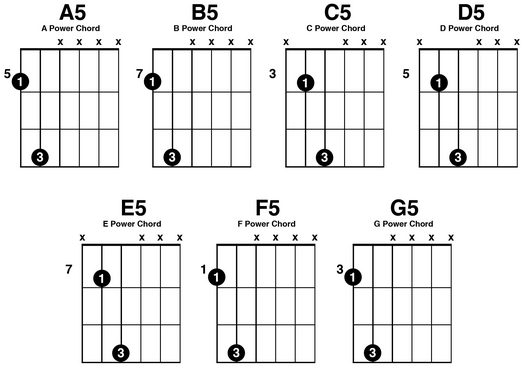
Bonus Easy Guitar Tip: You might play power chords to avoid a more difficult chord form, but sometimes they're recommended in the song. How can you tell? If you see a chord name that includes the number 5, like A5, or C5, the author is telling you to play a power chord.
Tip 6: Play A Substitute Chord
When you learn songs it's easy to think that the only acceptable chords are the ones listed. But, when you listen to a band, it becomes obvious that everyone is playing a slightly different note, pattern, riff, or chord... all of which compliment the other.
You can do the same thing... play a complimentary, or substitute chord... and it's easy to figure out (that's why it's an Easy Guitar Tip).
Here's the rule: if you're supposed to play a major chord, you can also count down two letters and play a minor chord. The reverse is also true: if you're supposed to play a minor chord, you can count up two letters and play the major chord.
For example, suppose you're supposed to play a B-minor (Bm), but it's either inconvenient, or difficult? Use this simple easy guitar tip to count up two letters (B...C...D) and play a D major chord. If you are supposed to play a G-major, you can count down (G...F...E) and play an E-minor instead.
Tip 7: Chukka-Chukka!
Sometimes you just can't get from one chord to another, and the other easy guitar tips don't work. It's OK, there's still a way to keep the song moving along... Instead of playing a chord, keep the song going by fully muting the strings and strumming to the beat.
Some call this full palm muting, some call it "chuckka chukka" or "scratchy-scratchy." Regardless of the term you use, this is a great way to fill in a few beats as you reposition your hands for the next chord.
To play a chukka-chukka, you will fully mute the strings with either hand. If using your fretboard hand to mute the strings, simply rest one or more fingers across all strings. If using your strumming hand, press the fleshy part of you hand (the fleshy part of you palm, nearest to your little finger) where the strings cross the bridge & saddle. Either technique can deaden the sound of ringing notes. Then strum as usual, keep the beat, and watch people marvel at your ability to improvise!
Tip 8: Use The "What was that?" Look
OK, technically this isn't an easy guitar tip, it is instead a way to admit a mistake while teasing another person.
I was given this advice by my original guitar instructor. He's played with hundreds of professional musicians, of all levels of ability. He's played with nationally touring bands, and is an occasional studio musician. I'm open to any and all advice he offers.
After working with me for about a year, he helped get me into the church praise band.
I practiced extra hard leading up to that first Sunday. I was as ready for my first guitar 'performance' as I was going to get.
Even with all the practice, I was a bit nervous. My instructor, probably sensing my unease, walked up to me and gave me our final easy guitar tip. He said, "If you make a mistake, just glance over at the keyboard player and make a face. Look at him as if you're asking, "What was that?!""
So, if you're ever in a situation where you're playing with others and just plain mess up, look over at the bass player, or the keyboard player, and use the "What was that?!" look.
Your Tips For Others!
Won't you share your best tips with others?
Tips From Other Visitors!
Click below to see contributions from other visitors to this page...
Bb Substitution for Dm (example: Beatles "It's Only Love") 




When I play the Beatles acoustic number "It's Only Love" in the key of C (not the original key but who cares?) I substitute Bb for Dm. B chords - even …
Making Your Own Music 




Playing your favorite music is fun, but you can develop a stale "copy and paste" sound by playing other people's music all the time.
Here's how I have …
Mission Strings And Have No Spares? Practice Anyway! 




Have you ever gotten lazy when you lose a string, and say hey, I can’t play my guitar anymore until I get strings, and then it just takes a long time before …
Play Air Guitar When Needed 




When you mess up (which is normal) and you don't know were your at just pretend to play.
This tip works really well when you're playing in front of …
musicmaker 




Make sure that your left thumb is what is holding the back of the neck! It makes it easier to play hard chords!!
Gtatmaster1 




Warm up those hands. Learn a song to keep motivated even if it is not a great first rendition.


